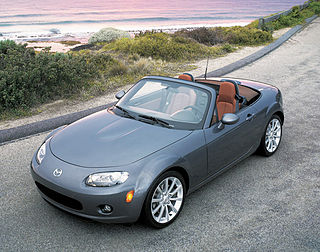
A convertible or cabriolet is a passenger car that can be driven with or without a roof in place. The methods of retracting and storing the roof vary among eras and manufacturers.

Automotive safety is the study and practice of automotive design, construction, equipment and regulation to minimize the occurrence and consequences of traffic collisions involving motor vehicles. Road traffic safety more broadly includes roadway design.
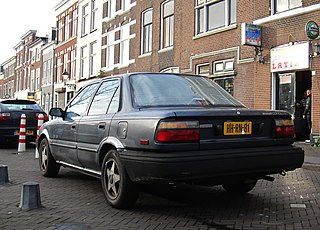
A sedan or saloon is a passenger car in a three-box configuration with separate compartments for an engine, passengers, and cargo. The first recorded use of sedan in reference to an automobile body occurred in 1912. The name derives from the 17th-century litter known as a sedan chair, a one-person enclosed box with windows and carried by porters. Variations of the sedan style include the close-coupled sedan, club sedan, convertible sedan, fastback sedan, hardtop sedan, notchback sedan, and sedanet/sedanette.

Coupé de ville — also known as town car or sedanca de ville — is a car body style produced from 1908 to 1939 with an external or open-topped driver's position and an enclosed compartment for passengers. Although the different terms may have once had specific meanings for certain car manufacturers or countries, the terms are often used interchangeably.
There are many types of car body styles. They vary depending on intended use, market position, location, and the era they were made in.

A dashboard is a control panel set within the central console of a vehicle or small aircraft. Usually located directly ahead of the driver, it displays instrumentation and controls for the vehicle's operation. An electronic equivalent may be called an electronic instrument cluster, digital instrument panel, digital dash, digital speedometer or digital instrument cluster.

The Dodge La Femme is a full-sized automobile that was produced by Dodge between 1955 and 1956. The automobile was specifically designed for women. The La Femme option was available on 1955 and 1956 Dodge Custom Royal Lancer models.
United States v. Ross, 456 U.S. 798 (1982), was a search and seizure case argued before the Supreme Court of the United States. The high court was asked to decide if a legal warrantless search of an automobile allows closed containers found in the vehicle to be searched as well. The appeals court had previously ruled that opening and searching the closed portable containers without a warrant was a violation of the Fourth Amendment, even though the warrantless vehicle search was permissible due to existing precedent.
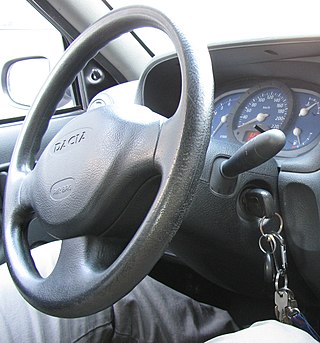
A car key or an automobile key is a key used to open and/or start an automobile. Modern key designs are usually symmetrical, and some use grooves on both sides, rather than a cut edge, to actuate the lock. It has multiple uses for the automobile with which it was sold. A car key can open the doors, as well as start the ignition, open the glove compartment and also open the trunk (boot) of the car. Some cars come with an additional key known as a valet key that starts the ignition and opens the driver's side door, but prevents the valet from gaining access to valuables that are located in the trunk or the glove box. Some valet keys, particularly those to high-performance vehicles, go so far as to restrict the engine's power output to prevent joyriding. Recently, features such as coded immobilizers have been implemented in newer vehicles. More sophisticated systems make ignition dependent on electronic devices, rather than the mechanical keyswitch. A number of these systems, such as KeeLoq and Megamos Crypto have been demonstrated to be weak and vulnerable to cryptanalytic attacks.

The trunk or boot of a car is the vehicle's main storage or cargo compartment, often a hatch at the rear of the vehicle. It can also be called a tailgate.

A motor vehicle has lighting and signaling devices mounted to or integrated into its front, rear, sides, and, in some cases, top. Various devices have the dual function of illuminating the road ahead for the driver, and making the vehicle visible to others, with indications to them of turning, slowing or stopping, etc., with lights also indicating the size of some large vehicles.
A glossary of terms relating to automotive design.

The center console or centre console in an automobile consists of the control-bearing surfaces in the center of the front of the vehicle interior. The term is applied to the area beginning in the dashboard and continuing beneath it, and often merging with the transmission tunnel which runs between the front driver's and passenger's seats of many vehicles.

Dorothy Elizabeth Levitt was a British racing driver and journalist. She was the first British woman racing driver, holder of the world's first water speed record, the women's world land speed record holder, and an author. She was a pioneer of female independence and female motoring, and taught Queen Alexandra and the Royal Princesses how to drive. In 1905 she established the record for the longest drive achieved by a lady driver by driving a De Dion-Bouton from London to Liverpool and back over two days, receiving the soubriquets in the press of the Fastest Girl on Earth, and the Champion Lady Motorist of the World.

A car door is a type of door opening, typically hinged on its front edge, but sometimes attached by other mechanisms such as tracks, for entering and exiting a vehicle. Doors most often integrate side windows for visibility from inside the car and can be locked to secure the vehicle.

A brougham was originally a car body style where the driver sat outside and passengers seated within an enclosed cabin, — deriving the configuration from the earlier brougham horse-drawn carriage. Similar in style to the later town car, the brougham style was used on chauffeur-driven petrol and electric cars.
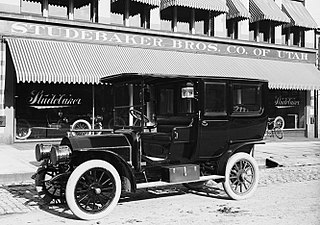
A limousine, or limo for short, is a large, chauffeur-driven luxury vehicle with a partition between the driver compartment and the passenger compartment which can be operated mechanically by hand or by a button electronically. A luxury sedan with a very long wheelbase and driven by a professional driver is called a stretch limousine.
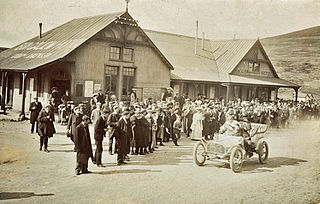
The 1905 International Tourist Trophy was an automobile motor race held on 14 September 1905 on closed public roads along the Highroads Course on the Isle of Man. It was organised by the Automobile Club of Great Britain and Ireland, and was the first time that what became known as the RAC Tourist Trophy was awarded. The race lasted over six hours and was won by John Napier, driving an Arrol-Johnston. Percy Northey finished second in a Rolls-Royce, while the Vinot-Deguingand driver Norman Littlejohn was third.

Car controls are the components in automobiles and other powered road vehicles, such as trucks and buses, used for driving and parking.

The Dodge Tomahawk is a non-street legal vehicle introduced in 2003 by Dodge at the North American International Auto Show, initially as a one-off concept, and then later that year as a limited production vehicle when DaimlerChrysler announced they would sell hand-built reproductions on order. The Tomahawk attracted significant press and industry attention for its striking design, its outsize-displacement, 10-cylinder car engine, and its four close-coupled wheels, which give it a motorcycle-like appearance. Experts disagreed on whether it is a true motorcycle. The Retro-Art Deco design's central visual element is the 500-horsepower (370 kW), 8.3-litre (510 cu in) V10 SRT10 engine from the Dodge Viper sports car. The Tomahawk's two front and two rear wheels are sprung independently, which would allow it to lean into corners and countersteer like a motorcycle.


















